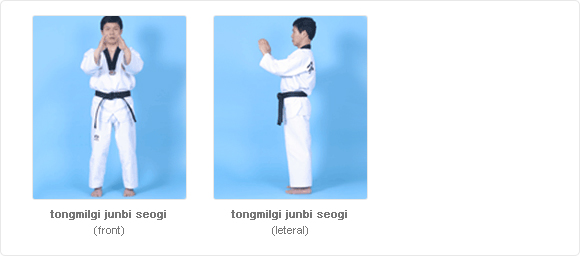Moa seogi (close stance)
- 1. Pose:
- Stand upright with both inner feet blades attached and stretch bothe knees.
- 2. Usage:
- It is used in charyotseogi, kkyopson-junbiseogi, bojumeok-junbiseogi, dujumeok-heori.
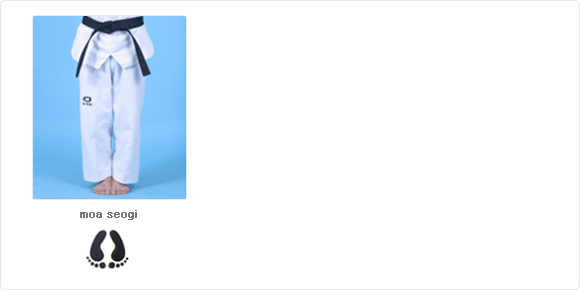
Dwichuk moaseogi (attention stance)
- 1. Pose:
- From a moaseogi, the back soles are left attached to each other but the only fore soles are opened at an angle of 60 degrees.
- 2. Usage:
- It is used in applicable action of seogi.
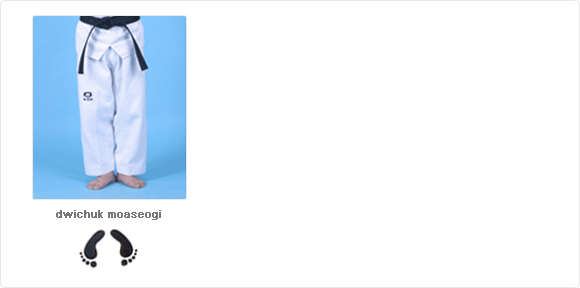
Apchuk moaseogi (reverse attention stance)
- 1. Pose:
- From a moaseogi, the first toes of feet are left attached to each other, opening the back soles apart from each other at an angle of 60 degrees. This is the reverse stance of the dwichuk-moaseogi.
- 2. Usage:
- Both apchuk moaseogi and dwichuk moaseogi are used to ready stances in a state of halt.
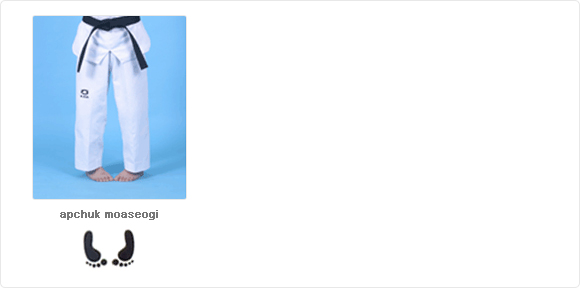
Kyotdari seogi (assisting stance)
- 1. Pose:
-
- The front foot, at its foot blade back (balnaldeung), is touched by the first toe of the assiting foot and the latter’s back sole is lifted up. only the fore sole touching the ground,
- The body is lowered by bending the knees as in the juchum seogi,
- The weight is supported only by the front foot, the assisting foot merely helping keep the balance.
- 2. Usage:
- This stance is used to make one thrust forward like an onrush.
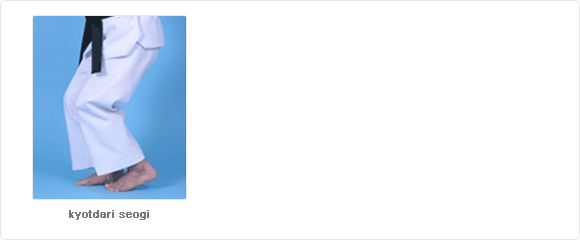
Apkkoa seogi (forward cross stance)
- 1. Pose:
- In case of a righthand apkkoa seogi,
- A righthand forward cross stance is a suspended stance of the momentary action when you move your right foot leftwards from either a riding stance or lowered riding stance,
- Draw your right foot to cross over the back of the left foot and place its fore sole by the smallest toe of the left foot. The movement should be made with the knees kept bent down and the shins of both feet will make an “x” sign, crossing with each other,
- Keep the two feet as near as possible, and
- When you paused in a righthand cross stance for a certain action, you must make the whole sole of right foot touch the ground, supporting your weight, and keep the left foot touching the ground only at its fore sole. At this moment, the shin and calf must firmly stick to each other. However, keeping the knees apart.
- 2. Usage:
- This stance is mainly used move side-wards.
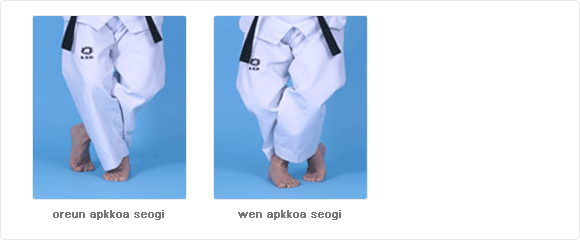
Dwikkoa seogi (backward cross stance)
- 1. Pose:
- The right foot thrusts forward pounding the ground and at the same time the left foot follows, placing its toes near the right foot blade to brake the movement. At this point, the right calf will strick to the left shin, making an “x” sign, and the two knees are also bent down.
- 2. Usage:
- With this stance, you can pound on your opponent’s foot back, approaching nearer for a second attack.
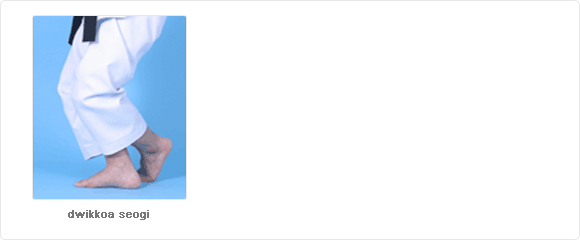
Hakdari seogi (crane stance)
- 1. Pose:
- First, bend and lower your right knee as in the riding stance and then lift up your left foot so that the back of foot blade may be placed close to the inner side of right knee. In this stance, the lifted up left knee will be tightened to protrude forward. If the left knee opens outward, keeping balnace will be difficult, and the next motion for an attack will be dull.
- 2. Usage:
- This stance help exercise the maintenance of balance and arouses confusion in the opponent because of your readiness to deliver kicks at any moment.
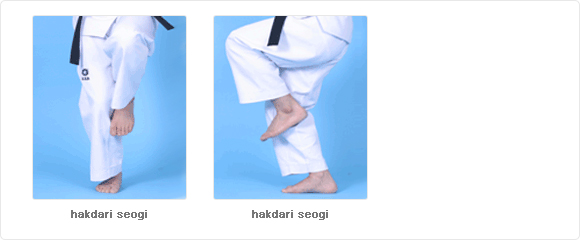
Ogeum seogi (reverse crane stance)
- 1. Pose:
- The same as the crane stance except that the foot back of lifted up foot placed on the hollow of the other leg’s knee.
- 2. Usage:
- Unlike the crane stance, this stance makes the supporting foot brake one’s forward thrust and the lifted up foot with its foot back placed on the hollow of knee helps keeping balance. This will enable one to give variations. in kick techniques, either front or sidekick.
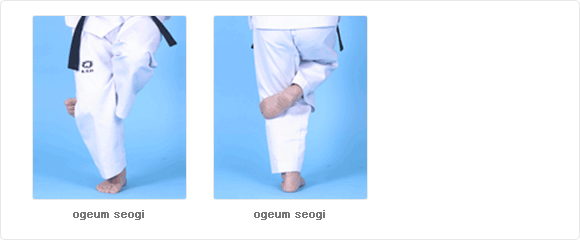
Teuksu Poom seogi (special poom stance)
While the preceding seogis dealt with the techniques of keeping balance by use of two legs in various forms, the special poom stances will be described by the comprehensive motion of arms, legs and the trunk which are to make harmonized stances. The “poom” means a pose resulting from the motion taken in applying a taekwondo technique.
Dujumeokheori Jumbi seogi (fist on waist ready stance)
- 1. Pose:
-
- Kept the feet as in the “close stance.”
- Place the fist on the side of waist, each hand back facing the ground, and
- Other things, such as the body, eyes conditions of mind and respiration control, are like the basic ready stance.
- 2. Usage:
- A stance of readiness to begin movements.
- 3. Words of command:
- “Dujumeokheori junbi!”, stressing the last word, “junbi!”
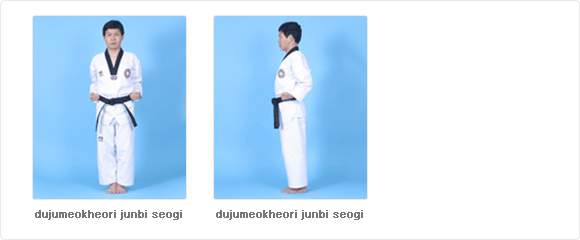
Kyopson Junbi seogi (overlapped hands ready stance)
- 1. Pose:
- Keep the two feet as in the close stance, keep the body as in the attention stance, overlap the stretched right hand with the equally stretched left hand, crossing each other. The fingers are stretched closed with each other, tighten the two overlapping hands but with a gap between the two by a paper’s thickness, and other things, such as the body, eyes, condition of mind and respiration control, are the same as in the “basic ready stance.”
- 2. Usage:
- This is used for a ready.
- 3. Words of command:
- “Kyopson junbi!” but the last word “junbi” must be uttered loud.
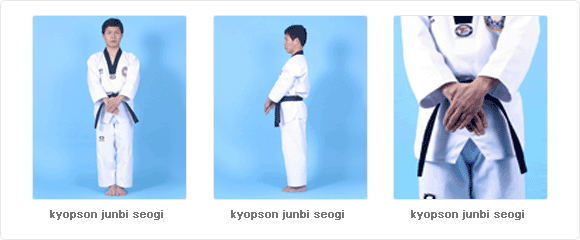
Bojumeok Jumbi seogi (covered fist ready stance)
- 1. Pose:
-
- Two feet are kept like a close stance,
- The other body sections are kept as in the basic ready stance,
- Lift the hands up to the breast and make the left hand cover the clenched right fist rolling up from the back or right hand with the four fingers excluding the thumb, as if wrapping a thing, and the left hand thumb covers the righthand one,
- Two arms from a circle by bending at the elbows, and
- The height of the hands may have three options; near the solar plexus or up the neck or up to the forehead.
- 2. Usage:
- This is used for a ready stance.
- 3. Words of command:
- “Bojumeok junbi!” also stressing the last word “junbi.”
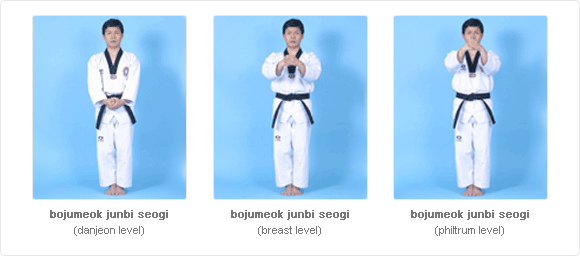
Tongmilgi Jumbi seogi (pushing hands ready stance)
- 1. Pose:
-
- Stand in the parallel stance,
- Keep two hands in the forms of sonnal (hand blade), lift up two hands, closing them nearer with the palms upward, up to the height of breast, the palms finally looking face to face, and then slightly push the hands forwards with the hand blades facing the front,
- When the hand are pushed forward, the hands must take a shape of holding a volleyball, and
- The hands will be slightly bent at the wrists toward the direction of thumbs and the elbows will be pushed forward at an angle of 120 degrees.
- 2. Usage:
- This is used for a ready stance.
- 3. Words of command:
- “Tongmilgi junbi!”, the last word “junbi” being accentuated as an ordering word.
